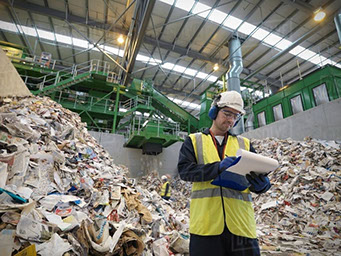Businesses and organizations generating large amounts of cardboard waste need efficient and reliable solutions for disposal and recycling. A heavy duty cardboard shredder is an essential piece of equipment designed to handle the toughest cardboard materials, providing a robust solution for industrial and commercial needs. Whether you’re running a warehouse, a shipping facility, or involved in recycling operations, understanding what makes a high-performance heavy duty cardboard shredder crucial can help you make informed decisions.
| For landfill-free waste and recycling services, including sorting, baling, shredding and compaction equipment, or to explore earning money from your recycling, contact Integrity Recycling Waste Solutions at (866) 651-4797. |
What Is a Heavy Duty Cardboard Shredder?
A heavy duty cardboard shredder is a specialized industrial machine designed to break down thick, bulky cardboard materials into smaller, manageable pieces. Unlike standard shredders used for paper or light materials, these machines are built with powerful motors, reinforced cutters, and sturdy frames capable of handling large volumes of dense cardboard at high speeds.
In simple terms, this shredder transforms large boxes, cartons, and sheets of cardboard into shredded fragments, which can then be compacted or recycled. They are an essential tool for waste management, reducing storage space, and facilitating easier recycling processes.
Why Choose a Heavy Duty Cardboard Shredder?
Selecting a heavy duty cardboard shredder offers numerous advantages:
- High Efficiency: Fast processing speeds for large quantities.
- Durability: Built to withstand continuous, rigorous use.
- Cost-Effective: Reduces labor costs and minimizes waste volume.
- Environmental Benefits: Promotes recycling and reduces landfill waste.
- Safety Features: Designed with safety mechanisms to prevent accidents during operation.
Understanding the core benefits underscores why investing in a quality heavy duty cardboard shredder can significantly improve operational workflows.
| For landfill-free waste and recycling services, including sorting, baling, shredding and compaction equipment, or to explore earning money from your recycling, contact Integrity Recycling Waste Solutions at (866) 651-4797. |
How to Choose the Best Heavy Duty Cardboard Shredder
When selecting a heavy duty cardboard shredder, consider the following factors:
Capacity and Size
Assess the volume of cardboard waste generated daily. Larger capacities and larger feed openings are suitable for high-volume environments.
Power and Motor Strength
A more powerful motor translates to better performance and the ability to handle thick, tough cardboard without jamming or overheating.
Cutting Mechanics
Decide between strip cuts, cross cuts, or a combination based on your recycling or disposal needs. Cross cuts provide smaller shredded pieces, enhancing security and compactness.
Durability and Build Quality
Opt for machines constructed with high-grade steel and reinforced components to ensure longevity and reliable operation over time.
Safety Features
Look for safety interlocks, emergency stop buttons, and sensor-based mechanisms to protect operators.
Budget
Balance your budget with required features; investing in a higher-quality shredder can save costs in maintenance and downtime later.
Maintenance and Ease of Use
Choose models that offer straightforward maintenance procedures and user-friendly interfaces, minimizing downtime.
Tips for Operating a Heavy Duty Cardboard Shredder Safely
- Always wear appropriate protective gear, including gloves and safety goggles.
- Regularly inspect blades and moving parts for wear and tear.
- Avoid inserting non-cardboard materials such as plastics or metals to prevent damage.
- Keep the area clear of obstructions and ensure proper ventilation.
- Follow the manufacturer’s instructions for operation and maintenance.
- Do not overload the shredder beyond its specified capacity.
Troubleshooting Common Problems
| Issue | Possible Cause | Solution |
|---|---|---|
| Jammed blades | Excessively thick or hard material | Feed smaller portions, clear jam carefully |
| Overheating | Continuous use without breaks | Allow cooling periods, check ventilation |
| Unusual noises | Loose or damaged blades | Inspect and tighten or replace blades |
| Reduced performance | Worn-out blades or motor issues | Schedule maintenance or blade replacement |
Comparing Different Types of Cardboard Shredders
| Feature | Cross Cut | Strip Cut | Granulator |
|---|---|---|---|
| Shred Size | Small, secure | Larger strips | Fine granules |
| Security | High | Moderate | Very high |
| Capacity | Varies | Varies | Usually high |
| Cost | Moderate to high | Lower | Higher |
| Ideal Use | Confidential documents, recycling | Packaging, bulk waste | Recycling facilities |
Summary: While cross-cut shredders provide enhanced security and smaller waste, strip cutters are suitable for rapid processing of less sensitive materials. Granulators excel in recycling plants requiring uniform particles for processing.
Conclusion
A heavy duty cardboard shredder is an indispensable tool for any business or facility dealing with significant cardboard waste. Its ability to efficiently handle dense, bulky materials saves time, space, and money while supporting environmentally friendly practices. By evaluating key features such as capacity, power, safety, and durability, you can select the model that best fits your operational needs. Investing in a high-quality heavy duty cardboard shredder ensures smooth, safe, and productive waste management, contributing to a cleaner and more sustainable environment.
Remember: The ideal shredder depends on your specific usage volume, material type, and safety considerations. Careful research and adherence to safety protocols will maximize your investment and operational efficiency.
| For landfill-free waste and recycling services, including sorting, baling, shredding and compaction equipment, or to explore earning money from your recycling, contact Integrity Recycling Waste Solutions at (866) 651-4797. |

